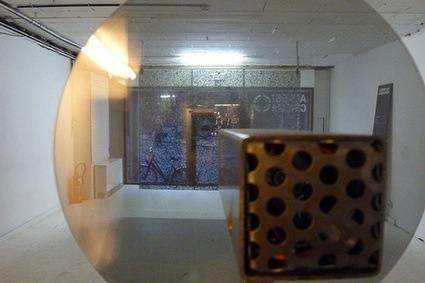

In this work Wim Janssen cuts polarization filter into small rectangles of one cm, in random orientations, like large pixels. These little squares are fixed between two large rectangular pieces of plexiglass. At first sight, the screen looks like a banal, slightly darkened window. But in front of this screen stands a slowly rotating disc, also made of polarization filter. When the screen is seen through this disc, it changes into a half transparent field of video noise.
This phenomenon occurs because lightwaves, besides their frequency and amplitude, also have an orientation. Polarization filter let light pass in only one direction. When you look through a piece of this filter, it's perfectly transparent, just a bit darker than normal plexi or glass. When you look through the filter at an other piece of this material which is rotated 90°, the second piece becomes an opaque black surface, because the light passing through the first filter, can't pass through the second filter. Every other orientation gives a different degree of opacity.
By cutting thousands of little pieces of polarization filter and putting a rotating polarization filter in front of them, Wim Janssen succeeds in imitating television static by using an almost banal technique.
-- EXCERPT FROM ARTIST'S STATEMENT
